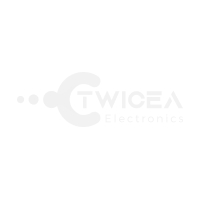You don't know what a DC motor is, how it works, or which one is right for you? Well, you're not alone as there are lots of people who struggle to understand what DC motors are and how do they work. But don't worry as we're here to help.
In this article, we will simplify the basics of DC motors and their different types and take you through various applications.
This guide will be very helpful for students, hobbyists, and professionals to understand everything about DC motors.
So, let us begin.
Understanding DC Motors
DC motors are machines operated by electricity that convert electrical energy from a direct current source into mechanical energy. They can be found in many applications, from small home appliances to substantial industrial mechanisms.
Basic Components of a DC Motor
Here is a circuit diagram for the DC motor that will help you understand the basic parts:
1. Stator: The stator is the stationary part of a motor and is a source of a magnetic field. It constitutes the outer frame of the motor with the magnetic poles of the motor, which are either permanent magnets or an electromagnet.
2. Rotor (Armature): The rotating part of the motor, where the armature winding is carried and in which the electromotive force is induced.
3. Commutator: A mechanical switch that alternates the direction of current in the armature winding at appropriate periodic intervals to ensure torque maintenance in one direction.
4. Brushes: Transfer current to the armature, making and breaking contact with the commutator—typically carbon or graphite.
5. Windings: Wire wound in a coil on the rotor, and sometimes on the stator, through which current flows to create magnetic fields.
Now you know the basics of DC motors, but you must be wondering how does DC motors work. Let's discuss this in detail.
The Functionality of DC Motors
Operation of a DC motor is based on the Lorentz force law, stating a current-carrying conductor placed in a magnetic field experiences a force.
Here's a step-by-step explanation:
1. Current Flow: If a DC voltage is applied across the motor's terminals, current goes through the armature winding.
2. Magnetic Field Interaction: The current flowing through the armature winding causes a magnetic field to be generated, which interacts with the separately produced magnetic field of the stator—a stationary part supplied by permanent magnets or field windings.
3. Force Generation: The magnetic fields interact with each other in such a way that, according to the Lorentz force law, there is a force developed on the armature due to which it rotates.
4. Commutation: The role of the commutator is to reverse the current in the armature winding because of the rotation of the armature so that a torque is always produced upon it in the same direction.
So that's how DC motors work.
ALSO READ: DC Voltage: What is It & DC VS AC Symbols
Types of DC Motors
There are 2 different types of DC motors are available in the market:
Brushed DC Motors:
They are the traditional types of DC motors and consist of a rotor or armature with windings connected to a commutator through brushes. Because of these brushes, electrical contact is given to the commutator so that current reverses in the rotor windings and allows the rotor to continue its rotation.
If a rotor is made to rotate, the commutator and brushes do their part in changing the direction of the current at the right moment so that the rotation never stops.
Brushed DC motors are simple, inexpensive, and suitable for applications where precise control is not crucial.
Brushless DC Motors:
Brushless direct current (DC) motors, sometimes called electronically commutated motors (ECMs), take one step beyond DC motors. They do not feature brushes and commutation any more as in the case of brushed motors.
Instead, signal transmission to the motor windings is applied to create rotating magnetic fields.
This design gives them several advantages: they are more efficient, have longer life, and require much less maintenance.
Brushless DC motors have far more applications that demand precision control, high efficiency, and reliability—for example, electric vehicles, drones, industrial automation, etc.
AC Motor vs. DC Motor
AC motors and DC motors are both used to convert electrical energy into mechanical energy, but they operate on different principles and have distinct characteristics.
AC Motor:
1. Operation: AC motors rely on alternating current, where the direction of current flow periodically reverses. The most common type of AC motor is the induction motor, which works on electromagnetic induction principles.
2. Types: There are several types of AC motors, including induction motors, synchronous motors, and brushed AC motors.
3. Speed Control: AC motors typically have fixed speeds determined by the frequency of the AC power supply. However, speed control can be achieved using variable frequency drives (VFDs) or by altering the number of poles in the motor.
DC Motor:
1. Operation: DC motors rely on direct current, where the flow of electric charge is unidirectional. They utilize the interaction between magnetic fields and current-carrying conductors to generate mechanical rotation.
2. Types: There are several types of DC motors, including brushed DC motors, brushless DC motors, and stepper motors.
3. Speed Control: DC motors offer precise speed control, which can be achieved by varying the voltage or using pulse-width modulation (PWM) techniques.
Here is an useful vedio
Applications of DC Motors
DC motors find application in various fields due to their versatility, precise speed control, and efficiency.
Here are some common applications:
1. Automotive: DC motors are used in electric vehicles (EVs) for propulsion, power steering, power windows, windshield wipers, and cooling fans. They are also utilized in hybrid vehicles and electric bicycles.
2. Industrial Machinery: DC motors are employed in various industrial processes for tasks such as driving conveyor belts, powering pumps, operating cranes and hoists, and controlling the speed of machinery.
3. Robotics: DC motors are widely used in robotics for precise control of robotic arms, grippers, and actuators. They provide the necessary torque and speed control required for robotic movements.
4. Home Appliances: DC motors are increasingly used in energy-efficient home appliances such as refrigerators, washing machines, vacuum cleaners, and air conditioning systems for improved performance and energy savings.
These are just a few examples of the wide-ranging applications of DC motors across various industries and sectors. Their versatility, reliability, and controllability make them indispensable in modern technology and machinery.
What is a DC Motor Driver?
A DC motor driver controls the speed and direction of a DC motor. It includes a power stage for bidirectional current control, control logic for interpreting input signals, PWM generation for speed control, current sensing for protection, feedback interface for precise control, communication interface for networked systems, voltage regulation for stability, and diagnostic features for fault detection.
Conclusion
In conclusion, DC motors are versatile devices that convert electrical energy into mechanical energy, finding use in various applications like automotive, industrial machinery, robotics, and home appliances.
So, whether you're a student, hobbyist, or professional, grasping the basics of DC motors can help you utilize them efficiently in your projects and applications.






